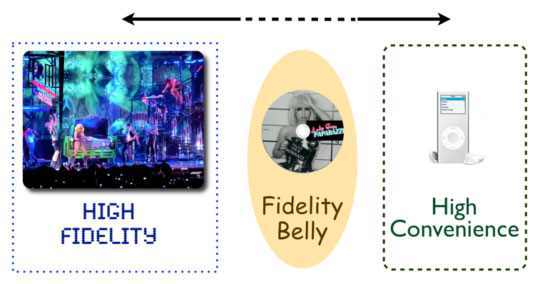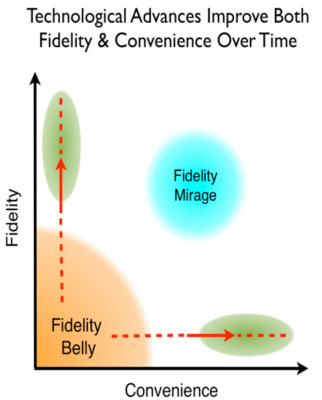
Vol. XIII, No. 2, February 2013
- Editor's corner
- Evidence that the staycation trend is both real & long-term
- Foundations Entertainment University - a 3-fer in March
- The bifurcated entertainment market; High Fidelity or die!
- A counterintuitive way to increase profits - scarcity
- 2012 North American cinema attendance increases
- Biases that can cause us to make bad decisions
The bifurcated entertainment market; High Fidelity or die!
In last month’s article, Location-based entertainment experience goes premium, we discussed how entertainment is found at the two extreme ends of a spectrum – High Fidelity which in this context refers to premium, first-rate location-based experiences and Convenience, mostly digital and virtual world experiences. This is known as a bifurcated market. High Fidelity is characterized by the quality of the experience and Convenience by both the ease of getting it and the ease and cost of paying for it . Think of a U2 or Lady Gaga concert as High Fidelity and MP3 music on an iPod or smart phone as Convenient. High Fidelity experiences are often difficult to get and command a high price. Convenient experiences are easy to get and inexpensive or free. You never want to be in between these two extremes, in what is called the Fidelity Belly that is neither High Fidelity nor Convenient. That is where the music CD ended up when MP3s took over Convenience end of the spectrum playing music . People will trade off quality for Convenience. In fact most MP3 music is actually lower music quality than the CD it replaced.

It is impossible to be both High Fidelity and Convenient at the same time. That is nothing but a mirage. Technology advances are constantly raising the bar at both ends of the spectrum.

Our article in this issue, Evidence that the staycation trend is both real & long-term, shows how consumers are changing their behavior based on the trade off between Fidelity and Convenience. As the article documented, less consumers are spending money at location-based entertainment venues on trips and vacations. The highest income households showed the smallest declines in participation and are representing an increasing share of the trip entertainment market, what is called social stratification. And those households that are spending are spending more money than in the past. This fits perfectly within the Fidelity trade-off. When consumers are choosing to visit an entertainment venue during a trip, they are picking the premium higher priced ones. And it is likely that the consumers who have stopped going on trips, or if they are still going, aren’t spending on location-based entertainment (proportionally more of lower income households) are consuming more of their entertainment at the Convenience end of the trade-off in the digital and virtual worlds.
What all this means is that to stay relevant to consumers and avoid sliding into the Fidelity Belly, location-based entertainment venues need to continually raise the quality of the experiences they offer, as technology is constantly improving the Convenience of digital and virtual entertainment. The more Convenient options become, the better the quality of the High Fidelity location-based entertainment options have to become to continue to attract consumers. And the fortunate paradox of this is that as the Fidelity of the bricks ‘n’ mortar experience improves, consumers are willing to pay an increasing premium price for it. With location-based entertainment you can no longer compete with price, you have to compete with quality to attract attendance. And that means every aspect of the experience, including the quality and appeal of atmosphere and décor, food and beverage, customer service and all aspects of the operations.
In today’s world, it is fast becoming High Fidelity or die for location-based entertainment venues.
Vol. XIII, No. 2, February 2013
- Editor's corner
- Evidence that the staycation trend is both real & long-term
- Foundations Entertainment University - a 3-fer in March
- The bifurcated entertainment market; High Fidelity or die!
- A counterintuitive way to increase profits - scarcity
- 2012 North American cinema attendance increases
- Biases that can cause us to make bad decisions


